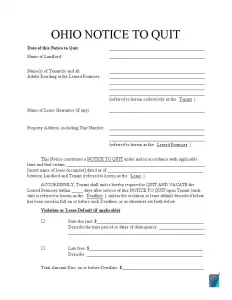Ohio Eviction Notice Forms
In Ohio, there are many documents regulating lease relations, and if most of them establish the beginning of these relations, then the eviction notice manages its end. The eviction notice template is the legal paper created mostly to represent the owner’s interests and not the interests of the resident.
The notice represents the will of the owner to terminate the rental relations with the resident. There are many reasons why the owner might take this decision. He might not like the fact you’ve hidden the presence of a pet, or maybe you delayed your payment. Sometimes there might be no reason at all. It is also possible in Ohio.
Receiving the eviction notice, the resident has some time either to eliminate the lease violation or move out of the apartment.

Build Your Document
Answer a few simple questions to make your document in minutes
Save and Print
Save progress and finish on any device, download and print anytime
Sign and Use
Your valid, lawyer-approved document is ready
Ohio Eviction Laws
In Ohio, the eviction laws are very explicit; thus, lease papers have to meet the Ohio state laws, or they won’t have validity. And that will give the renter the right to stay in residence as long as he wants. In a situation like this, state laws of Ohio will choose the side of the renter because they require the owner to respect the resident’s interests till the lease agreement termination.
Documents specifying the eviction details process in Ohio:
- Ohio Revised Code, Chapter 5321 — Landlord and Tenants;
- Ohio Revised Code, Chapter 1923 — Forcible Entry and Detainer (Eviction);
- Franklin County Municipal Court Local Rules;
- City Ordinances;
- The Ohio Fair Housing Law.
These legal rental papers establish the period of time for the renter after getting the eviction notice during which he or she can comply. The owner has to wait till it happens, or till it doesn’t happen. Only after this period, the landlord can sue the lessee in court.
Suppose the landlord doesn’t wait till receiving the court order and begins to change the locks or disconnect the utilities. In that case, the tenant has the full right to sue against a landowner in court, as the landlord’s actions will be considered illegal.
It is also prohibited to evict the renter due to his or her gender, disability, age, the color of their skin, religious preferences, family status, or race. Ohio state laws also forbid the owner to remove the renter out of the apartment if the renter contacts the housing authorities and informs them about the unfit conditions of living.
Ohio Eviction Notice Laws Details
| Rent Grace Period | Not specified |
| Notice of Non-Payment | 3 days |
| Notice of Non-Compliance | 3 days |
| State Laws | Ohio Revised Code, Chapter 1923 |
Eviction Notice Types Used in Ohio
Eviction notices in Ohio act as legal confirmation of the fact the owner of the apartments notified the renter about the lease termination. Without this evidence, the owner can not sue the renter in court.
There are four types of eviction notices used in Ohio.
30-Day Notice to Terminate a Month-to-Month Tenancy
- 5321.17 of the Ohio Revised Code controls the notice.
Both the owner and renter might use this notice to protect their interests. That’s why it can’t be called a real eviction notice because there’s no violation of the lease on its basis. It’s just the letter informing the party of the agreement about the termination of the lease within 30 days.
30-Day Notice to Quit for a Health or Safety Hazard
Details of this notice are covered by § 5321.11 of the Ohio Revised Code.
It states that if there’s a danger to the safety or health of the owner of the apartment, he might ask the renter to move out of the apartment due to these circumstances. The renter still has 30 days to eliminate the issue, or he leaves the apartment. If after 30 days the situation hasn’t changed, the owner may sue the renter in court, and a 3-Day Notice for non-compliance must be issued.
3-Day Notice to Quit for Non-Compliance
- 1923.02 and §1923.04 of the Ohio Revised Code establish rules for this notice of eviction.
By sending this notice, the owner shows the renter that he somehow breached the lease agreement and has only three days to clean up the mess. If not, the tenant is obliged to move out of the apartment. It’s essential to describe the violation with as many details as possible.
3-Day Notice to Quit for Non-Payment of Rent
- 1923.02 and §1923.04 of the Ohio Revised Code are responsible for this notice.
As it’s clear from the name, this notice is given in the situation of the late payment or non-payment of the rent. The notice must cover the amount of money the renter has to pay, the time given for that, and the instructions on how to do it. The renter has three days to complete the payment; alternatively, he has no choice but to move out of the apartment.

Official Form Preview
OHIO
Pursuant to Ohio Revised Code 1923.04
TO: |
, Tenant; |
, Tenant |
|
, Tenant, |
And all other occupants |
The purpose of this letter is to demand that you vacate (LEAVE) the premises now in your
possession located at, in
_______________ Township, ____________________ County, Ohio on or before THE THIRD
DAY AFTER THE SERVICE OF THIS NOTICE. Premises means the structure, or living unit that you have been renting as well as any lot of land included in the rental agreement.
This demand is based upon the reason(s) checked below:
Failure to pay rent and other obligations: |
$ |
, rent |
|
$ |
, rent |
|
$ |
, other |
YOU ARE BEING ASKED TO LEAVE THE PREMISES. IF YOU DO NOT LEAVE, AN EVICTION ACTION MAY BE INITIATED AGAINST YOU. IF YOU ARE IN DOUBT REGARDING YOUR RIGHTS AND OBLIGATIONS AS A TENANT, IT IS RECOMMENDED THAT YOU SEEK LEGAL ASSISTANCE.
, 20____ |
, Landlord |
|
, Address |
|
, Phone |
|
|
|
|
Eviction Process in Ohio
There is a special eviction procedure created by the state of Ohio for those who want to terminate the lease agreement due to some serious reasons or for no reason at all. Remember that all your actions must meet the requirements of Ohio; alternatively, they won’t have validity.
Here’s the guide on the eviction process, following which both the renter and the owner will know how to complete the procedure in accordance with the Ohio state laws.
Create the Notice Form
Choose the notice which suits your interests the most and complete it on your own, or use our form-building software to speed up the process.
If you do it yourself, make sure you include all necessary information as it has to be a legal information letter for the renter explaining why he or she receives this notice.
What to include in the notice:
- The name of the eviction notice with the right period of time and the cause of its creation (for example, non-payment);
- The date of the creation of the notice;
- The renter’s full name;
- The full address;
- Give the cause of creating this notice in the first place;
- Give the name and contact details of the apartment owner;
- Provide the signature of the landowner.
Bring the Notice to the Renter
It’s better to do it personally, but you can also use confirmed mail for this.
File a Complaint in Court
The owner needs to file a complaint in the municipal court and settle fees of $123.
Fill In the Summons Form
The Summons Form states the fact of the lawsuit being issued.
Wait for the Court Hearing
The hearing is usually arranged within 30 days after the renter receives the summons. It can’t be done less than seven days after the summons arrived at the holder.
If the holder wants to protect himself in court, he has to come there. Otherwise, the judge will choose the side of the owner.
In the case the judge chooses the owner’s side, he issues the Writ of Execution, meaning the renter must leave the apartment immediately.
Ohio Eviction Court Forms
As it was already mentioned, there are special forms the court requires to be filled in while applying for the eviction process.
- An Eviction Notice
It’s the main eviction document without which the eviction process can’t be completed lawfully.
- A Complaint Form
The Complaint Form contains accusations of the owner on the renter’s behavior in relation to the owner’s property. All possible details must be given.
- Summons Form
In this form, the owner states the fact of issuing the lawsuit against the renter.
- Writ of Execution
The last owner’s warning to the renter is saying he has to leave the owner’s property as soon as possible if he doesn’t want to have problems with the law.

Interested in other Ohio documents? We offer free forms and a straightforward customization experience to anyone who prefers less hassle when confronted with paperwork.
